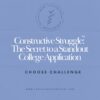
I got on an airplane July 2nd for the first time since February. Wishing to visit an elderly parent, I was finally willing to accept the risk to fly across the country. I was nervous. I wore two face masks, a plastic shield, gloves, and a disposable poncho (yeah, I was the only one dressed this way). Taking these precautions, I was willing to accept the uncertainty of this risk for the reward of visiting my mom. So much in life depends on how much uncertainty we are willing to withstand.
How risk-tolerant are you? This principle can be applied to the college admissions process. Assessing your student’s own risk tolerance level is a crucial component in determining to which Early Decision (ED) school he/she should apply. Four years ago, the Dean of Admissions, from the University of Chicago, was presenting at my son’s school in Los Angeles and made a statement that stuck with me. “If your child is only applying to schools with a less than 20% acceptance rate, it is like playing the lottery.” He made this remark to a room full of anxious parents, knowing nothing of the students’ abilities or portfolios – but in his mind, even in the best case scenario – the risk was like playing roulette. In determining where your child should apply ED, much depends on your student’s and family’s risk tolerance. The complexity of this decision is compounded by all the uncertainty caused by COVID-19.
My close friend’s daughter, Emma, was in the college applicant pool last year. She achieved top grades and scores, had a passion for computer science, and her dad is an involved Penn alum. He told me that Emma was NOT applying early to Penn, but to a different highly selective, elite institution. I reiterated that Penn specifically takes legacy into account during the ED cycle, but tends to attribute less importance to legacy during Regular Decision (RD). Understanding the increased uncertainty the father stated, “Look, my daughter knows that if she does this, she probably will end up at one of her likely schools. She is ok with that. She is willing to take this risk to reach for her dream.” She embraced the potential repercussions of her decision and chose to make it anyway. Against the odds, she was accepted, big risk, big reward. She has high risk-tolerance.
Our client Henry also has a high level of risk tolerance, but he balanced uncertainty with smart, safety nets. He is a top student, with a 31 ACT, at a reputable, public high school in Los Angeles. Henry is a passionate journalism student and his dream was to attend Medill at Northwestern. Having said that, Henry and his family knew that applying ED to Northwestern was a longshot, as it is for most applicants. They also understood that they likely were using the “ED bump” on Northwestern. While Henry’s grades matched Northwestern’s range, his ACT was slightly below it. Henry’s family was hopeful, but not delusional. They allowed Henry to shoot for his dream, but worked with us to curate a carefully balanced list of schools, with higher acceptance rates, that boast prominent journalism programs. As expected, Henry was not accepted to Northwestern. However, because we carefully, realistically, and authentically formulated his list, Henry is at peace, content with his results, enthusiastic about his future.
This past admissions season, we witnessed many students choose to manage their expectations differently. The trend was for top academic students, with low risk tolerance, to apply ED to schools with higher acceptance rates. They opted to forgo their “moonshot” and apply ED to a target school, hoping that ED applicants receive extra consideration. In one particular situation, Nick’s dream was to play water polo for Brown. The coach liked Nick and offered him a walk-on spot if he were able to get in on his own, but the coach was not actively recruiting him. Nick knew Brown was a longshot for anyone. Nick and his family decided to skip the drama of disappointment during ED season, and apply somewhere they knew Nick had a better chance of being accepted. In Nick’s case, this meant Wash U, definitely not a second tier, but clearly offering a higher acceptance rate than Brown (particularly ED). Most significantly, the Wash U coach was willing to support Nick’s application. In Nick’s case, living his dream means attending a school he was excited about, even if it was not his first choice, and playing water polo.
The only point in all of these stories is to follow your dreams, but know how much risk you can tolerate. There is a quote, author unknown, posted above the door of the Olympic Training Center in Colorado Springs that says, “Risk everything, regret nothing.” This quote inspires two meanings, the first is that if you are passionate about something, there is nothing more important than pursuing it – no matter how difficult it is. Give it your all. Leave nothing on the table. The difficulties are mere tests to temper you and make you stronger. I also ascribe to this quote, a second interpretation. If you are willing to go for it and risk everything, you cannot later regret or second guess your decision. You have to accept the outcome, let it go, knowing that it was a huge risk. Success would be amazing, but disappointment is more likely, so have no regrets.






